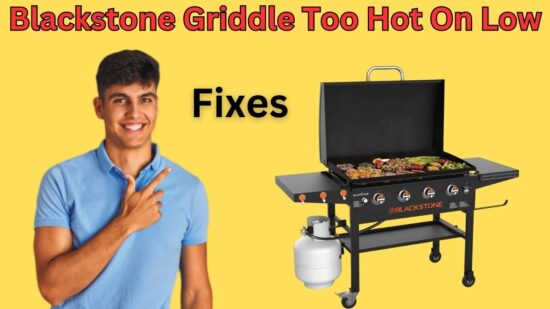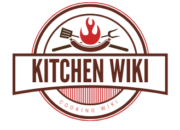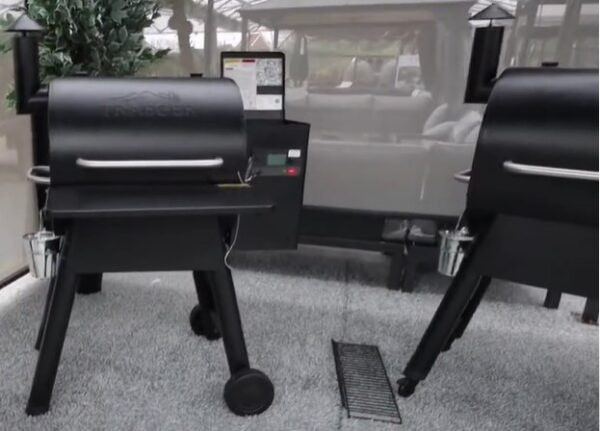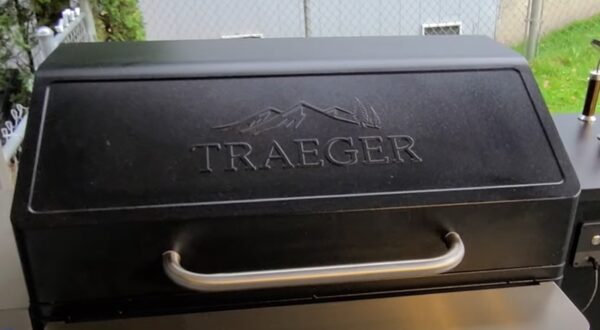Are you having trouble with your Blackstone Griddle getting too hot on low? You’re not alone. Many griddle owners have experienced this issue, and it can be incredibly frustrating.
Fortunately, there are some easy solutions that will help you get the perfect temperature for your food every time.
In this article we’ll go over some of the most common causes of a Blackstone Griddle getting too hot on low as well as how to fix them.
With just a few simple changes, you’ll be able to enjoy delicious meals cooked perfectly every time!
How To Fix Blackstone Griddle Too Hot on Low Problem

1. Improperly Calibrated Thermostat
An improperly calibrated thermostat on a Blackstone Griddle can prevent it from heating correctly on low settings. A thermostat is an essential part of the griddle as it is used to regulate the temperature of the cooktop surface.
If the thermostat is not correctly calibrated, then the griddle may be too hot or too cold compared to what the user has set.
This can lead to frustration as food may overcook or undercook, and users may not be able to properly control their cooking temperatures.
Additionally, this improper calibration can cause damage to both the griddle and any surrounding kitchen surfaces as they become exposed to higher temperatures than intended.
To ensure proper temperature control on a Blackstone Griddle, it is important to check and recalibrate its thermostat periodically.
2. Overzealous Preheating
Overzealous preheating is a common issue and can be frustrating when griddling. Preheating is essential for any cooking method, but it’s especially important when using a Blackstone Griddle.
When the griddle is preheated to high temperatures over an extended period of time – usually more than 10 minutes – the heat can be too intense and cause food to burn on the surface. This causes problems like sticking, charring, and overcooking.
The best way to avoid this problem is by not preheating the griddle too much. Start low and gradually increase the heat as needed depending on what you’re cooking; use medium heat for most items and raise it when necessary.
Additionally, use oil or butter to create a layer between the food and the surface before cooking to help prevent sticking or burning.
It’s also important to note that undercooking food can also lead to sticking if it’s not cooked completely through, so make sure everything is cooked at the right temperature and for the proper amount of time.
3. Not Enough Cooking Oil
One of the main reasons why a Blackstone Griddle may become too hot on low heat is due to not having enough cooking oil.
This can happen when not enough oil is applied directly to the griddle surface or if there isn’t an adequate layer of oil between the cooking surface and food being cooked.
This lack of oil leads to the griddle overheating, which can cause uneven cooking and burning of food.
To ensure an even, consistent temperature while cooking on a Blackstone Griddle, it’s important to apply enough oil to the cooking surface. Depending on what type of food is being cooked and how much fat content it has, some oils work better than others for this purpose.
Generally speaking, high-quality vegetable oils such as olive or avocado are best for higher-heat cooking due to their high smoke points.
If a Blackstone Griddle becomes too hot on low heat, it’s important to turn off any heat sources and allow the appliance to cool down before attempting to continue with cooking.
To avoid this issue from occurring in future cooks, make sure you use an ample amount of oil that has a high smoke point and regularly check that your griddle isn’t overheating by testing the surface temperature with an instant-read thermometer during your cook session.
4. Burned Residue on Griddle
Burning food residue on your griddle can create a nasty and persistent problem. The issue arises when food sticks to the griddle surface, gets charred and is left behind.
This charred residue can build up over time, creating a thick black layer of carbon-like material that’s difficult to remove without heavy scrubbing.
One main reason this issue occurs is due to having the heat set too high while cooking. While it may be tempting to crank up the temperature in order to cook faster, this will lead to food sticking and burning more easily, leaving more residue on the griddle surface.
It’s important to keep an eye on the temperature setting and adjust accordingly.
In order to remove existing burned residue from your griddle, there are several options you can try.
First off, try heating your griddle before cleaning with a nonabrasive cloth or brush like a nylon scouring pad or plastic brush. Heat will help loosen up stuck on debris so they are easier to remove.
If this doesn’t work, use a degreaser like a dish soap or baking soda paste followed by wiping down with cloth or paper towel and rinsing thoroughly with hot water afterward.
Finally you can also invest in some specialty products designed specifically for removing carbon buildup from cooking surfaces such as grill brushes or stone cleaners – these are typically safer than chemical solvents and make quick work of stubborn stains!
5. Accumulated Grease & Debris
Accumulated grease and debris is a common causes of a Blackstone griddle heating up too hot on low. Grease that has built up over time, especially near heating elements, can cause excessive heat.
This heat can damage the griddle and even start a fire if not properly addressed.
The best way to prevent this issue is to regularly clean the griddle surface with a solution of warm water and mild soap.
It’s also important to scrape away any hard buildup using either a metal spatula or scraper. Doing this helps remove any accumulated grease and debris which might be preventing proper heat distribution across the cooking surface.
It’s also important to oil your griddle regularly. Using a high-temperature food grade oil like avocado or coconut oil provides an extra layer of protection against excess heat build-up due to grease or debris accumulation.
By spreading a thin layer over the entire cooking surface, you will help make sure that heat is evenly distributed across the entire cooking surface instead of in one concentrated area caused by built-up debris.
6. Improperly Placed Thermometer
One of the main reasons why a Blackstone Griddle can become too hot on low is because the thermometer may not be placed properly.
The thermometer must be mounted in the correct position in order for it to accurately measure the temperature of the griddle. If it isn’t placed correctly, then it won’t be able to effectively detect the temperature of the griddle and could result in it becoming overheated.
The solution to this issue is to make sure that the thermometer is installed properly on your Blackstone Griddle.
This can usually be done by following any instructions provided with your product manual or by consulting a professional who will be able to assist you with installation.
Additionally, regularly checking and cleaning your thermometer can help ensure that it is always functioning at optimal levels and providing an accurate temperature reading.
7. Poor Ventilation
Poor ventilation can be a major factor in why your Blackstone Griddle is too hot on low settings. Without proper ventilation, heat builds up and can cause your griddle temperature to rise above what you have set it to.
To resolve this issue, make sure that there is adequate ventilation around your griddle. This can be achieved by moving the griddle away from walls or other obstructions, and ensuring that any vents are not blocked or obstructed.
More it, if using an outdoor griddle, consider investing in a cover for the grill to protect against weather-related issues.
Finally, if all else fails, you may need to invest in a fan designed specifically for griddles to help keep temperatures regulated.
8. Blocked Vents
Typically, when a Blackstone Griddle is too hot on low, it’s due to blocked vents. The griddle has multiple vents that allow airflow and help regulate the temperature.
If the vents become blocked with debris, dust or dirt, the temperature increases and can cause the griddle to become too hot on low settings.
To prevent your griddle from becoming too hot on low settings, you should regularly clean its vents. This can be done by using a damp cloth and wiping away any debris or dirt that may have accumulated in the vents.
You can also use a vacuum cleaner to suck up any larger pieces of debris that could be blocking the vents. After cleaning out the vents, make sure they are not completely blocked before operating your griddle again.
9. Incompatible Cookware
In some cases, the Blackstone Griddle may become too hot on the lowest setting if used with incompatible cookware.
This can occur when using cookware made from materials like copper or aluminum, which are poor conductors of heat and can cause a buildup and transfer of excessive heat to the griddle.
To avoid this issue, it is best to use cookware that is made of stainless steel or cast iron, as these materials are better conductors of heat and will not cause an excessive build-up of heat.
10. Incorrect manual settings
Incorrect manual settings is one of the main reasons why a Blackstone griddle may become too hot on low. This could be due to incorrect temperature settings, placing the griddle on a too high or too-low setting.
It can also occur if the knob gets stuck in an intermediate position, so it’s not actually set at the desired temperature.
To address this issue, it’s important to make sure that the knob is correctly calibrated and regularly cleaned to ensure that it can move freely and accurately set the temperature.
Additionally, check all of the bolts on the griddle to make sure they are properly tightened before use, as loose parts can cause inaccurate readings.
Finally, familiarize yourself with the temperature settings for different types of food you will be cooking so you can correctly adjust your stovetop accordingly.
Conclusion
The Blackstone griddle is a great tool for outdoor cooking, but it’s important to be aware of the fact that even on low heat settings, the temperature can become too hot.
This could potentially lead to food being overcooked or burnt if left unmonitored. To prevent this from happening, make sure you keep an eye on your griddle while in use and consider investing in a thermometer so you can accurately gauge the right temperature setting for whatever dish you are preparing.
With some careful monitoring and practice using your Blackstone Griddle, you will soon have perfectly cooked meals every time!
FAQs
How hot does Blackstone griddle get on low?
The Blackstone Griddle can reach temperatures of up to 400°F on low settings.
The temperature is adjustable depending on what you’re cooking.
Why is my grill burning too hot?
This could be caused by a blocked air vent, which is restricting the airflow and causing the temperature to rise.
Check your vents for any blockages and make sure they are clean so that air can pass through freely. If this doesn’t solve the problem, contact a professional to inspect your grill for further diagnosis.
How do you adjust the flame on a Blackstone griddle?
The flame on a Blackstone griddle can be adjusted by turning the control valve clockwise to increase the flame and counter-clockwise to decrease it.
Be sure to use caution when adjusting the flame, as it can get very hot quickly. Additionally, you should always ensure that all fuel sources are extinguished if finished using your griddle.
Can a griddle get too hot?
Yes, a griddle can get too hot. If your griddle is set to low temperatures and it feels overly hot, that means the heat setting may be too high for your needs and should be adjusted.
Too-high heat can cause food to burn quickly or unevenly cooked dishes. It’s best to keep the temperature lower than necessary and monitor it throughout use.
Pit Boss Pro Series 850 Problems
Traeger Pro 34 Temperature Problem


